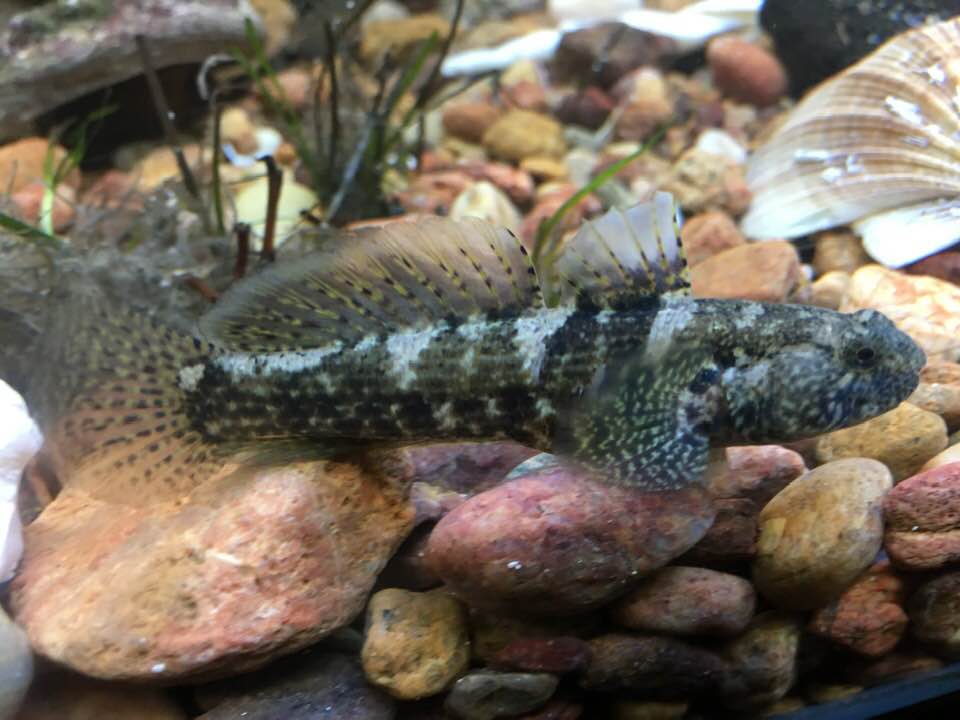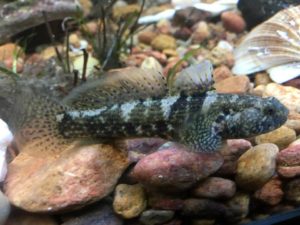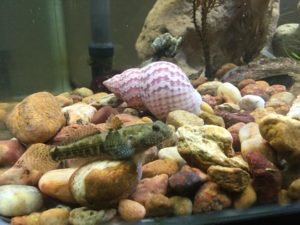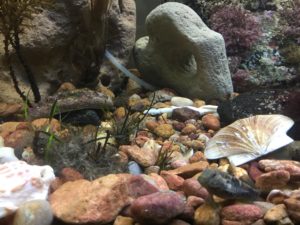The Observed Behaviour of a Mating Pair of Krefft’s Frillgoby in an Aquarium
by Steve Reynolds (as told to him by Dion Clarke)
Dion Clarke recently posted this photo on the SA Natureteers Facebook page: –
It was accompanied by the comments: – “Yesterday, we noticed an orange fish in our seawater aquarium, (we don’t have an orange fish). It was doing a little mating dance in the weed, then the bottom of its head turned purple-black, then its whole head, and finally, it was completely black. It then proceeded to lay eggs, in its abalone shell home, and then, changed back to its original colours. (Caught in local waters, Port Lincoln.)
It was great to read Ian Gibbins’s comments about colour change in fish – “Fish can change colour like this by two mechanisms: hormonal via the pituitary gland; or via sympathetic nerves. in each case the colour change is effected (sic) by pigment cells in the skin that can aggregate or disperse melanin granules to lighten or darken the skin respectively. If the colour change occurred over several minutes, then it was probably hormonal (as would befit reproductive behaviour); if it happened more quickly that that (e.g. a few seconds), then it would have been neuronally mediated. And, of course, both mechanisms can be activated in turn under some conditions.”
Dion gave me permission to use his goby photo for this article, and also confirmed the identification of the goby species – Krefft’s Frillgoby, Bathygobius kreffti (krefftii). He also sent me two more photos for me to use, along with these details about Krefft’s Frillgoby: –
“Usually found in seagrass beds, which is unusual for frillgobies. The populations in SA gulfs are isolated, and not connected east and west of here. The nearest populations out of the gulfs are in NSW. Also found in QLD. On further reading it appears the male tends the eggs, and he is very diligent and territorial.”
This is some very good information from Dion. I had originally asked Dion if there were more than one goby in the aquarium. “Yes, we have two,” he said, “The first picture shows the female,”: –
“And the second shows the female at front right and the male under the (half size) Abalone shell at back left.”: –
I have previously written about Krefft’s Frillgobies on four occasions, as follows: –
https://mlssa.org.au/2018/02/08/the-japanese-goby-is-similar-to-kreffts-goby/
https://mlssa.org.au/2017/06/13/congolli-pseudaphritis-urvillii/
https://mlssa.org.au/2017/03/25/further-discoveries-at-the-ships-graveyard/
https://mlssa.org.au/2017/10/16/kreffts-frillgoby-bathygobius-krefftii/
When Dion read this, my published article , he commented, “Hey Steve, great article, however I do believe we were watching the male change colour, and we missed the female slip in and lay the eggs. He is still quite dark, and hides when I try to photograph him.”
It is important that we now formalise Dion’s observations.
Dion’s fish came from the Port Lincoln area.
The male (now) turned orange and then did “a little mating dance in the weed”.
“The bottom of its head then turned purple-black, then its whole head, and finally, it was completely black.”
The female “then proceeded to lay eggs in its abalone shell home …..”
Later comments by Dion were: –
“She does seem to go darker, when in her shell”, and (she is) “about 8cms long”.
This is all very important in the context of fish behaviour, colour change, mating and breeding behaviour. Many thanks got to Dion for providing us with this information.




